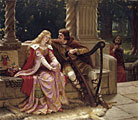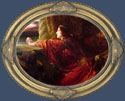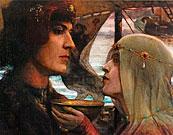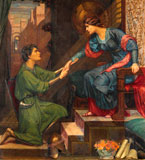Illusions Gallery - Fine Art Prints on Canvas
The Story Behind the Painting: "TRISTAN AND ISOLDE"
and the Pre-Raphaelite Painters
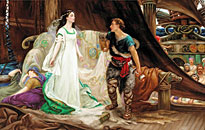
Tristan and Isolda
Herbert James Draper
The release of the feature film "Tristan and Isolde" brought new attention to an old legend - one that has invited homage by writers and artists throughout the ages from its beginnings (believed to be around the 5th century AD.) The legend itself has known countless interpretations: Richard Wagner wrote his famous opera, many widely-known poets including Tennyson and Swinburne penned their versions of the story, and - fortunately for us! - the story served as a rich source of inspiration to the Old Master painters. Though the legend pre-dates the often-interpreted stories of Camelot and King Arthur, it has become so intertwined with those stories as to be commonly assumed to be a part of them. The simple basis of the legend is this: a brave young English knight, Tristan, falls in love with a beautiful Irish princess, Isolde (pronounced ee-ZOLD-uh) and they share a love potion that binds them forever. The twist in the romance comes from Isolde's betrothal and marriage to King Mark of Cornwall - Tristan's uncle - and the obstacles that arise from their forbidden, and doomed, love. Among the Old Masters to pay homage to the knight and his princess are four very well-known and accomplished late 19th-century Pre-Raphaelite painters featured predominantly on this site. Edmund Blair Leighton (British, 1853-1922), an eminent artist of the Pre-Raphaelite movement, painted his vision of Tristan & Isolde in 1902; in this painting, the pair are seen conversing privately outdoors while, unbeknownst to them, King Mark looks on. Scottish artist John Duncan (1866-1945) leaned toward the Celtic Revival and Pre-Raphaelite styles and created his Tristan & Isolda - a more somber image depicting their sharing of the love potion that doomed them - in 1912. John William Waterhouse (British, 1849-1917) was known for his love of classic legend and mythological themes and, though his style was primarily NeoClassical, ("new classic,") he is widely considered to be one of the premiere Pre-Raphaelites; his interpretation, also depicting the significance of the love potion, was painted in 1916: Tristram & Isolde (full title "Tristram and Isolde Sharing the Potion.") Our fourth popular Pre-Raphaelite painter, Sir Frank (Francis Bernard) Dicksee (1853-1928), became president of the Royal Academy of Art (England) in 1924 and was knighted in 1925; his portrayal of Isolde, date unknown, is titled Yseult and depicts the young princess watching through a window for her love to return. The various spellings of the names - Tristan and Tristram, and Isolde, Isolda, and Yseult (among others) stem from their Celtic origin and later Anglicization. To further explore the works of these artists and other Pre-Raphaelite painters found on IllusionsGallery.com, follow these links: John William Waterhouse Sir Frank (Francis Bernard) Dicksee Edmund Blair Leighton John Duncan The Pre-Raphaelites article by Kathleen McGloin, Illusions Gallery, copyright 2018
